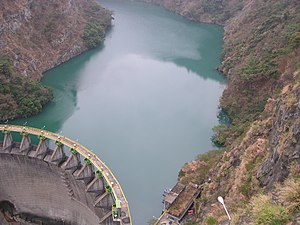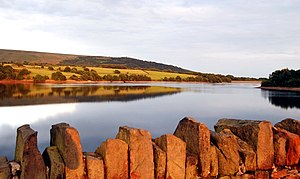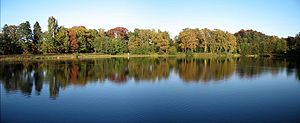| Revision as of 02:19, 15 April 2008 editENeville (talk | contribs)Autopatrolled, Pending changes reviewers8,208 edits Intro edit: rm "broadly" etc per comment at Talk, dam info at dam← Previous edit | Revision as of 10:17, 15 April 2008 edit undoTedickey (talk | contribs)Extended confirmed users, Pending changes reviewers, Rollbackers54,484 editsm reservoirs don't have to hold waterNext edit → | ||
| Line 4: | Line 4: | ||
| ], ]]] | ], ]]] | ||
| A '''reservoir''' is, most broadly, a place or hollow vessel where something (usually ]) is kept in ], for later use. Most often, a reservoir refers to an ] ], used to store ] for various uses. Reservoirs are created first by building a sturdy ], usually out of ], ], ], or a mixture. Once the dam is completed, a ] is allowed to flow behind it and eventually fill it to capacity. Reservoirs exist in a wide variety of shapes and sizes, and can be either natural or man-made. | |||
| A '''reservoir''', is a body of water created behind a ] for various purposes including ], ], ], and ]. | |||
| ==Construction== | ==Construction== | ||
Revision as of 10:17, 15 April 2008
| This article does not cite any sources. Please help improve this article by adding citations to reliable sources. Unsourced material may be challenged and removed. Find sources: "Reservoir" – news · newspapers · books · scholar · JSTOR (December 2006) (Learn how and when to remove this message) |

A reservoir is, most broadly, a place or hollow vessel where something (usually liquid) is kept in reserve, for later use. Most often, a reservoir refers to an artificial lake, used to store water for various uses. Reservoirs are created first by building a sturdy dam, usually out of cement, earth, rock, or a mixture. Once the dam is completed, a stream is allowed to flow behind it and eventually fill it to capacity. Reservoirs exist in a wide variety of shapes and sizes, and can be either natural or man-made.
Construction
There are two basic types of reservoir: the commonly-seen dam across a valley, or the less-common fully-bunded dam.
A fully water tower bunded dam has a continuous man made embankment around its entire perimeter, most commonly using a central clay core as the waterproof element. The core is held in place by earth or rock piled either side of it in suitable volumes to resist the outward forces exerted by the water. The clay is joined directly to the natural underlying material, which itself is usually clay in order for the dam to be water tight. The reservoir is filled by mechanical pumps that draw water from an adjacent water course such as a river.
If a water tight roof is added then this dam can then be used for storing treated water before it goes to the tap and is known as a "Service" reservoir.
The more common dam across a valley relies on naturally formed features to form the water tight elements. Generally, surveyors have to find river valleys which are deep and narrow; the valley sides can then act as natural walls. The best place along the valley for building a dam has to be determined according to where the dam can best be tied into the valley walls and floor to form a water tight seal. If necessary, humans have to be re-housed and/or historic sites have to be moved, e.g. the temples of Abu Simbel before the construction of the Aswan Dam, creating Lake Nasser in the Nile River, Egypt.

First, the river must be redirected slightly so as to not disturb construction of the dam. Once that is done, building of the dam may commence. This may take anywhere from a few months to a few years, depending on its size and complexity. After the dam is complete, the river is allowed to begin filling the large area behind the dam.
Some reservoirs are entirely underground. In the United Kingdom Thames Water has many underground reservoirs beneath London built in the 1800s by the Victorians, most of which are lined with thick layers of brick. Honor Oak Service reservoir, which was completed in 1909, is the largest of this type in Europe. The roof is supported using large brick pillars and arches and the outside surface is used as a golf course.
Operation
A raw water reservoir doesn't simply hold water until it is needed. It is the first part of the water treatment process. The time the water is held for before it is released is known as the retention time, and is a design feature that allows larger particles and silts to settle out as well as time for the biological treatment of algae and bacteria by plankton-like creatures that naturally live within the water.
Water is then released from the reservoir, generally by gravity, to be cleaned for drinking water. In the event that major rain occurs, water can be released, decreasing the reservoir's water level.
Levels
The normal maximum level of a reservoir lake is called full pool, while the minimum level it can function at is dead pool. The water below this point is also called the dead pool, while the water in between is called the conservation pool. Full pool may have different levels in summer and winter, or based on the local wet and dry seasons.
Once a reservoir reaches dead pool, it is below the level at which the dam can release it downstream. At this point, the streambed beyond the dam goes nearly or completely dry, and electricity production stops as well. This is also often the point at which intakes for municipal water systems begin to suck air in, and must be extended into deeper water, where stagnant water quality is much poorer. This can be done either permanently with longer pipes, or temporarily with large hoses floated on small barges, such as until a severe drought or dam repairs are over.
Hydroelectricity
A hydroelectric power station consists of large turbines that rely on a gravity flow of water through pipes from the dam to turn a turbine, which in turn turns a generator to produce electricity. The water can then be either released to the surrounding watercourse or pumped back into the reservoir and reused. Generally, hydroelectric dams are built specifically for electricity generation and are not used for drinking or irrigation water, however metropolitan areas may find the water is needed later on.
Controlling watercourses
Reservoirs can be used in a number of ways to control how water flows through downstream waterways.
Irrigation
Water in an irrigation reservoir is released into networks of canals mainly for use in farmlands or secondary water systems. Water in an irrigation reservoir is generally not used for drinking water, but in some cases is. As with all reservoirs, water can be released if the reservoir is too full.
Flood control
Commonly known as an "attenuation" or "balancing" reservoir, these are used to prevent flooding to lower lying lands, flood control reservoirs collect water at times of unseasonally high rainfall, then release it slowly over the course of the following weeks or months. See transvasement.
Compensation
If a standard reservoir is built on a river which is used as a source of power, a compensation reservoir may also be built to guarantee a sufficient flow of water downstream during the working hours of the water-powered industries.
Canals

Where a natural watercourse's water is not available to be diverted into a canal, a reservoir may be built to guarantee the water level in the canal; for example, where a canal climbs to cross a range of hills through locks.
Recreation
Reservoirs often provide for recreational uses. Most reservoirs are built for a civic purpose, but still allow fishing, boating, and other activities. At most reservoirs, special rules apply for the safety of the public.
List of reservoirs
Main article: List of reservoirsLargest reservoir by region
- Northern Europe: Lokka in the municipality of Sodankylä in Northern Finland 417 km²
- Western Europe: The IJsselmeer 1,250 km²
List of reservoirs by area
Main article: List of reservoirs by areaThe following are the world's ten largest reservoirs by surface area:
- Lake Volta (8,482 km²; Ghana)
- Smallwood Reservoir (6,527 km²; Canada)
- Kuybyshev Reservoir (6,450 km²; Russia)
- Lake Kariba (5,580 km²; Zimbabwe, Zambia)
- Bukhtarma Reservoir (5,490 km²; Kazakhstan)
- Bratsk Reservoir (5,426 km²; Russia)
- Lake Nasser (5,248 km²; Egypt, Sudan)
- Rybinsk Reservoir (4,580 km²; Russia)
- Caniapiscau Reservoir (4,318 km²; Canada)
- Lake Guri (4,250 km²; Venezuela)
List of reservoirs by volume
Main article: List of reservoirs by volume| This list is incomplete; you can help by adding missing items. |
Other uses
A water tank is also a reservoir, feeding into a local water system when demand is high, and refilling when it is low. Typically they are placed in a higher part of the area it serves, so the system is gravity-fed from it.
A reservoir may also refer to the water for a steam iron or humidifier, or collected from a dehumidifier or air conditioner (before being carried or pumped outside, respectively). The term is also used for perfumes and liquid air fresheners, as well as the paint bottle for airbrushes, or for any other spray or atomizer.